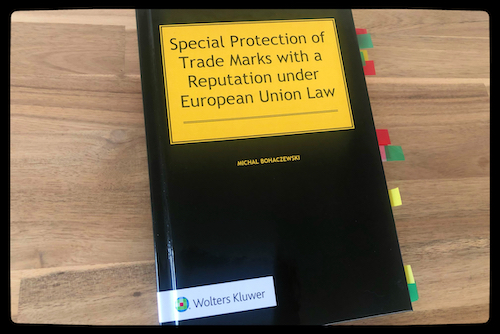Trade marks with a reputation (TMwR) in the EU and the additional layers of protection provided to them, like the famous trade mark regimes in other jurisdictions in general, is a controversial subject surrounded by unresolved problems of ambiguity and uncertainty that, sometimes, involves political databases over, for instances, the threshold of reputation. The shift in the essential function of trade marks, from an anti-deception regime to a strong property-based regime, has been accompanied by both questions and attempts at justification.
Having been delving into comparative research on famous trade mark regimes for a while herself, this Kat was very interested to read Special Protection of Trade Marks with a Reputation under European Union Law by Michal Bohaczewski (Assistant Professor at the University of Warsaw), which presents a comprehensive guide to EU law practices concerning TMwR.

This book features a clear three-chapter structure with detailed case studies and analyses the threads of Regulation 2017/1001 and Directive 2015/2436.
Specifically, the first chapter sets out the framework of the special regime for TMwR protection. Beginning with the source of the trade mark principle of speciality, it then reviews the types of use that fall outside the speciality, the legal grounds for special protection, the conceptual distinction between TMwR and well-known trade marks, and the different mechanisms of protection chosen by the national legislations of the EU Member States. The first chapter paves the way for a proper understanding of the research subject.
The second chapter examines the conditions common to all forms of infringement of TMwR. The author identifies distinguishes between positive conditions (i.e. prerequisite conditions that are necessary to a right holder’s establishment of infringement and invocation of special protection) and negative conditions (i.e. conditions that may preclude the alleged infringement).
The third chapter elaborates on the distinction between the forms of infringement of TMwR – including dilution, tarnishment, and free riding – and explains how they could be demonstrated in various proceedings. This Kat found the sections discussing the fundamental issues (e.g. the legal nature of repute and the rationale for condemning unfair advantage) to be of particular interest. Taking a multi-faceted approach, the author expounds on the three recognised forms of infringement and the reasons they are held independent from each other. And, as noted in the foreword by Prof. Dr. Maciej Szpunar, Advocate General at the Court of Justice, the author’s views on that point are very well argued.
This book takes a comprehensive approach in its examination of TMwR. It looks into both the Trade Marks Directive and the Regulation and brings both EUTMs and national trade marks into the discussion. The book contains a wealth of case law passed through the Court of Justice and the General Court of the EU, as well as the decisions issued by the EUIPO.
The author shows his ease with a wide range of in-depth methods of exploration, using his strong command of several non-English languages, e.g. French and Polish. Undoubtedly, new data will contribute to broadening the existing work in this field – where English-language research has been predominant – and shed light on several new opportunities for research, debate, and practice to be explored in the future.
This Kat found this thought-provoking book indispensable reading for researchers in relevant fields, who are engaging in probing key issues rather than make mere textual comparisons. Moreover, the author does not solely address academic readers. Instead, he arranges the contents in a clear and readable way, explaining many practical points (e.g. the proof of reputation, the proof of a link between different trade marks, and the involvement of freedom of expression), which makes the book a handy reference and a useful tool for a large readership, including readers in legal practice.
Product line: Kluwer Law International
Available from Wolters Kluwer in hardback – $152.00
Publish date: 15 April 2020
ISBN: 9789403520216
SKU: 10082007-0001
[Originally published on The IPKat on 27 October 2020]